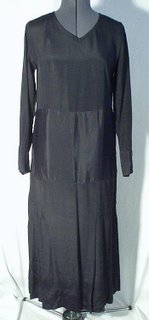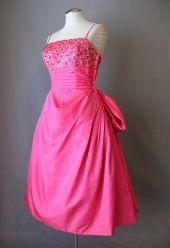
Here is a deceptively simple 1940's playsuit by well known sportswear designer Carolyn Schnurer. This suit appears to be a straight cut bodice with a flared skirt. But take a closer look at how the designer has attached that skirt.
See those intricate zig-zag seams at the waist? If you've ever tried to sew a V neckline, you know how difficult it is to get these V pointed seams to lie perfectly flat. And yet, here are several of them all the way around the waistline! And there's more...
Additional seams extend diagonally up from the center front seam to the bustline. These seams draw the eye in to the center waist and help give the illusion of a slender middle.
None of these decorative seams is necessary to the finished garment, and they certainly added to the difficulty of manufacture and cost, but I think this playsuit is much more interesting and effective with them. Don't you?
See this playsuit and more at Couture Allure Vintage Fashion .





















